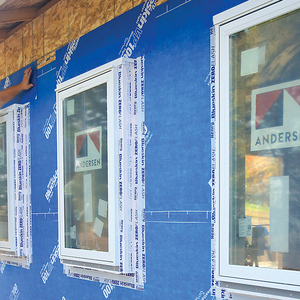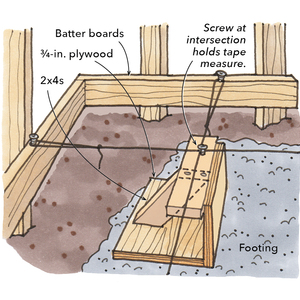Is it ok to use standard zinc plated bolts immersed in concrete as anchor bolts for a joist ledger? Any issues with reactivity? Thx….
Discussion Forum
Discussion Forum
Up Next
Video Shorts
Featured Story

The crew talks about work start times, fire-resistant construction, fixer-uppers, building Larsen trusses, and AI for construction.
Featured Video
Video: Build a Fireplace, Brick by BrickHighlights
"I have learned so much thanks to the searchable articles on the FHB website. I can confidently say that I expect to be a life-long subscriber." - M.K.
Fine Homebuilding Magazine
- Home Group
- Antique Trader
- Arts & Crafts Homes
- Bank Note Reporter
- Cabin Life
- Cuisine at Home
- Fine Gardening
- Fine Woodworking
- Green Building Advisor
- Garden Gate
- Horticulture
- Keep Craft Alive
- Log Home Living
- Military Trader/Vehicles
- Numismatic News
- Numismaster
- Old Cars Weekly
- Old House Journal
- Period Homes
- Popular Woodworking
- Script
- ShopNotes
- Sports Collectors Digest
- Threads
- Timber Home Living
- Traditional Building
- Woodsmith
- World Coin News
- Writer's Digest


















Replies
Treated or untreated wood ledger?
Dry,damp, wet location?
Zinc coat will not last long in wet/damp environment.
Zinc will corrode away if in treated lumber.
..........Iron Helix
They will rust off, right at the concrete/air joint. I am not sure exactly what the reaction is but that is where it happens.
I almost always use black non plated steel , if you are going to have any corrosion problems you should look at changing your construction methods. I've done plenty of renos where 20 - 50 year bolts look as good as new, and renos on more recent buildings where the bolts were rotted away because they used PT plates instead of good building design.
my 2 cents
Rik
Sorry, a bit more info...The joist ledger is a 1 3/4" thick versalam ledger that will be bolted to a stemwall. (We are pouring the stemwall tomorrow.) The architect originally called for using 5/8 x 8" black j bolts. Trouble is, nobody makes 5/8 x 8" j bolts- 10" is the shortest, and the wall is 8"Wide, and is already formed and drilled- can only insert the 10" j bolts if the wall is dissassembled.I ran this past the architect, and he suggested 5/8 x 8" zinc bolts with a washer- just drop 'em in. The ledger will hold joist hangers for I-Joists, on top of which goes plywood, then a 4" slab of concrete. (It's a garage.) There is lots of airspace around the ledger, and it moisture should not be a problem. I'm mainly concerned about reactivity and degradation of the bolts embedded in concrete- is zinc suitable for this?
Cut the damn 10" bolts to 8". Put a nut on each bolt before you cut it so you can unscrew it afterwards and straighten out the bunged threads. Ordinary hacksaw will cut black j-bolts with no trouble at all.
Do not use galvanised bolts in concrete.
PS--Never ask an architect how to solve a technical problem. That's not his job.
His job is to create technical problems.... <G>
Dinosaur
How now, Mighty Sauron, that thou art not broughtlow by this? For thine evil pales before that whichfoolish men call Justice....
Dinosaur,We use all kinds of galvanized connectors in concrete and have never had a problem. Simpsom has quite a few in their catalog that we use. Anchors, holddowns, straps, post bases, bolts ect. Galvanized rebar exist but I have never used it.KK
I have never even heard of galvanised rebar, let alone seen any. Hmm. I guess I learned something new today.
Dinosaur
How now, Mighty Sauron, that thou art not broughtlow by this? For thine evil pales before that whichfoolish men call Justice....
"PS--Never ask an architect how to solve a technical problem. That's not his job.His job is to create technical problems.... <G>"Word. Funny thing is, the guy was a builder/contractor for many years before becoming an architect.By the way, the bolts I'm talking about are zinc plated, not galvanized like the Simpson materials.The ledger requires 24 bolts- I'm not excited about the prospect of hacksawing them all off (though it's a good, obvious suggestion).And by the way (again), the architect spec'd 24" zinc plated threaded rod also embedded in the wall as the shear hold-down anchors. I would have considered the Simpson galvy stuff, but their galvy threaded rod is 12" max.Thanks again.
Edited 6/14/2009 5:54 pm by jjapogee
The way I'm reading this is that you are attaching a ledger to the SIDE of a stem wall - is this correct?Therefore, you are relying on the shear strength of the bolts to hold the ledger, I-joists, plywood and concrete.Why wasn't the top of the stem wall formed as a ledger for all this stuff and you wouldn't need to worry about the length and type of embedded bolts.Regarding threaded rod as anchors - we use the stuff, but drill after the pour and epoxy the rod in for precise positioning. The epoxy coating on the rod is applied in a quantity sufficient to squeeze out and coat the rod where it passes through any other material, treated or otherwise, which negates any corrosive effect the treatment might have had on the rod.I order lengths of allthread to fit the job but on occasion need longer lengths that are not available. A bimetal hacksaw blade in a sawzall makes short work of any cutting to length and the proper coupling nut completes the job.
Yes, the ledger is going to be bolted to the side of the stemwall, and I-Joist hangers will be attached to it. I don't know why the architect drew it this way- in retrospect, it makes perfect sense to simply form the wall to accommodate the I-joist. In any case, the plans were approved by the county planning (for whatever that's worth). Live & learn.The guy at my local non-big-box hardware store offered to cut the j-bolts with their re-bar cutter. Ten minutes, and all 24 were done. They are now sitting in the forms, waiting for mud.Another, related question, though- since it is now pretty common to have a PT sill plates, shouldn't the anchor bolts be treated/rated for ACQ contact? Does such a thing exist? The most common anchor bolt I've seen everywhere is the standard, black, made in who-knows-where j-bolt...those aren't rated for ACQ contact, are they?Sorry for what may be pretty silly questions. I do appreciate your thoughts.
we use some zinc plated canchor bolt last saturday in a pour. It was an engineered building, so I guess the engineer did not have any problem with it.
"The guy at my local non-big-box hardware store offered to cut the j-bolts with their re-bar cutter. Ten minutes, and all 24 were done."Did he cut off at the threaded end or the bend?If he cut off the thread end did he "straighten the threads" and if he cut off the "bend" then you have lost the structural value of the anchor bolt.As to the treated plates and anchor bolts...the AWPA says that anchor bolts 1/2" diameter and larger do nor have to be hot dip galvanized....BUT many yards are sending hot dipped anchor bolts and many of the specs via architects callout hot dipped galvanized at a minimum.I can attest to the corrosiveness of ACQ through numerous field observations and I strongly suggest taking a very conservative approach to assure no failure due to corrosion.By-the-way..."rated for use in all treated lumber" does not mean it will not corrode and it usually means a 3-5 year warranty and most structures are to be used far longer than 3-5 years. Be Wary!!............Iron Helix
For some reason, 1/2" and up bolts in direct contact with ACQ are not considered at risk for destructive corrosion. We avoid that risk entirely by drilling our anchor positions after the pour and using the Simpson or Hilti epoxy to set our anchors. Since plates are already in place and tacked or screwed down to prevent accidental movement the epoxy excess is forced out of the drilled hole and coats the anchor where it goes through the treated plate.I like using the zinc coated allthread because the plain steel we usually get can build a nasty amount of surface rust from laying around on the job site that must be wire brushed at the insertion end so we get better adhesion.A note of caution: If you ever have a job that requires a pull test on your anchors and you use epoxy, be sure that your drilled hole is as deep as the engineer calls for or DEEPER, the proper diameter for the anchor used, wire brushed as clean as you can get it,(blow or suck out all the dust) and then use enough epoxy so that you are certain that the entire rod is coated top to bottom. Then don't move the rod while the epoxy sets.Nothing worse than having a rod fail the test and they make you do every anchor point (the whole job) over again.
"Did he cut off at the threaded end or the bend?"Well, contrary to the impression that my questions here might have created, 'mama didn't raise no fool'- I threaded on the nut first, cut the threaded end, then backed off the nut (with a bit of force) to clean up the threads. The returns on the bolts are intact.Since all of the anchor bolts on this stemwall are 5/8", it would seem that the ACQ corrosion issue is a non-issue. At least for now. I hope.